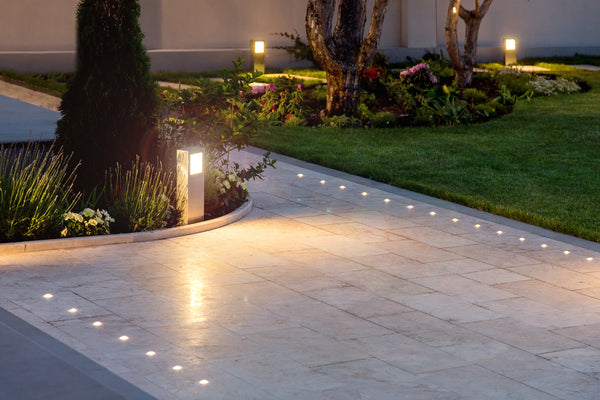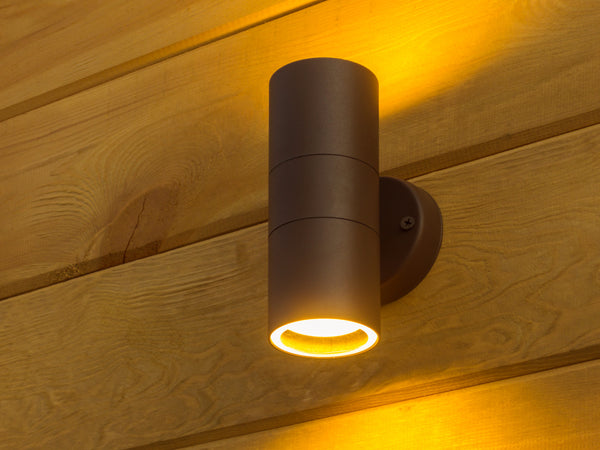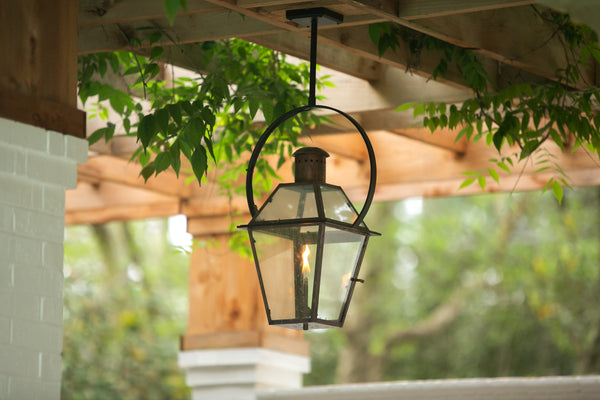On orders $99+
On orders $99+


With summer just right around the corner, it should be no wonder to see your neighbors make adjustments to their backyard, however minor or a complete overhaul it may be. And these observance should come without prejudice. It is, after all, the season to be outdoors. Should you want to join in on this trend. Good news! We are here to hopefully inform you the basics of outdoor lighting.
While the entryway sets the expectations for the remaining parts of the house, it is usually the façade or maybe a viewable-from-the-outside backyard that imprints first impressions. Exterior lighting requires just as much thought as interior lighting; one might even remark that it requires a slightly more meticulous plan due to some outdoor lights being uninstall-able unless you're making adjustments/alteration to the area it is being installed to (i.e. landscape lighting); being unprepared can most certainly catch one off-guard and be left frustrated.
One factor to consider--although situational--is paint as some would need to identify if the coating the fixture has is marine-grade or not which is something quite important for those who live in a nearby body of water.
Another factor for some fixtures is their location rating; the case being whether the fixtures are damp or wet-rated.
First off, two terms that are significant for this particular discourse are wet rating and damp rating. To put it simply, wet rated fixtures are lights that can be installed in a location where it might get exposed and make direct contact with water; as outdoor fixtures are typically installed, well...outdoors, a significant amount are wet rated. Damp rated fixtures are reserved more for areas that are exposed to moisture but won't be in direct contact with water. These areas are usually covered patios, decks and porches.
If you're worried about trying to figure out whether a light is wet or damp rated, you shouldn't be; information as important as this is usually provided upfront, whether that be in the form of a print on the box, stated specifically in the name, or by simply asking the salesperson or vendor of whom you are looking to purchase it from; we are proud to say we are privy to this information and are eager to share them.
Security lights serve as, hopefully, one of the many surveillance device someone has at their home or any area for that matter. Security lights function with motion sensors, and these motion sensors have different types, some of which--and at same time--the most common ones, have been conveniently listed below along with a brief yet essential explanation of how they function:
Passive Infrared (PIR)
PIR or passive infrared sensors detect a change in infrared radiation. The human body emits heat levels more than most objects, hence, when a person moves through its range, the sensor will be able to discern a relative change of temperature that in turn signals the lights to turn on.
Microwave
Microwave sensors emit high frequency radio waves. These sensors function much like a radar. Once it detects a change in frequency, it triggers the motion detector which causes the lights to go on.
Dual Tech/Hybrid
Hybrid sensors use both mechanics of the two aforementioned types. It is said to trigger less false alarms as it needs to confirm both a change in temperature which the PIR sensor employs and movement detection through shifts in frequency, utilized by the microwave sensor.

Landscape lighting needs careful planning on how and where to install. Most recommend sketching how you want your lights to be arranged first, then finding out if you want to use a direct line from the house or a transformer (low-voltage). Good news about low-voltage installation is that it does not require you to be a certified electrician (for DIY people out there) whereas direct line voltage necessitates the installation be done by a professional. Deciding on which to proceed with will influence the fixtures you will purchase and is also the case vice versa.
If proceeding with low-voltage, you would first need to determine the best location for the transformer. It is usually placed at the exterior walls of your home, ideally in a place where it is the safest and has the easiest access to your electrical line but is also relatively optimal to its distance to where you would have the landscape lighting fixture installed; it also needs at least one feet of clearance in every direction. An interest in low-voltage would mean that you are interested in DIY installation. If so, please bear in mind that installing the transformer outside can be done on your own but if the wires need to go through a wall, a professional electrician is required. Wires are commonly installed underground, providing an additional task of making shallow trenches in your backyard to get them properly placed. Another aspect of landscape lighting is the wiring method one is to use. The most common methods and a brief description of them are listed below:
Daisy Chain Method
The Daisy Chain method is a running series that is basically a chain of fixtures connected to a single wire. The home run is initially connected to the first fixture and it carries the current to subsequent connected fixtures. Though this is widely accepted as the easiest method, a drop of voltage from the very first fixture to the last one can occur.
T Method
The T Method is similar to the daisy chain method, the only difference being the first fixture being in the middle of the chain rather than being the the first one of either side. Deciding to use daisy chain or t method usually relies on placement and arrangement of the lights relative to their individual distance to the transformer, whether the ones on either side of the chain is closer (daisy chain) or somewhere in the middle (t method).
Hub Method
The Hub Method involves the use of a hub junction. The home run is connected to the hub and each fixture has an individual separate wire that is connected to it. This makes it so that the voltage of each light is equal but at the same time require the most amount of wires.

Path lights are commonly used for illuminating pathways in the area. It should be a primary function of these lights to brighten walkways ensuring safe treading on what would be an otherwise dark terrain. I said common in the previous statement due to the fact that people do also use them as complementary accent lights to spot lights or highlighting plants and garden décor.
If you want to know what distance is ideal for how far apart path lights should be, then most would recommend about 6-10 feet apart for optimal luminance. Of course, it would depend on how much lumens your light fixture has as well as preferability on how they should look for you.
Flood lights are used to illuminate a large area, having a wider beam spread compared to spot lights (more than 60 degrees). The farther away it is from what it is lighting on, the wider the coverage of its illumination. Flood lights are also the common fixtures used for security lighting.
As a side note: the recommended wattage range for bulbs to use outdoor are at 40-80 watts for incandescent bulbs (about 430-1052 Lumens). This is to comply with the dark sky lighting policy. If your area does not have this policy then in terms of practicality, more than 80 watts for a bulb can be too bright.
Spot lights act primarily as accent lights. They have a narrow beam spread that is used to highlight a specific place or object. They can most likely be the most versatile type of outdoor fixture in terms of aesthetics as they can easily be moved around and their direction guides how a highlighted object is illuminated or how their silhouette is going to present hence the many techniques for spotlighting that exist. Well known techniques are highlighting, silhouetting, shadowing, grazing, moonlighting, spotlighting, floodlighting.
Well lights are flushed in-ground that light up vertically and can also be used as a highlighting instrument much like spot lights. Its most practical and frequent use is accent lighting for ponds.

Deck lights are lights specifically used in decks or patios. They can be recessed lights or sconces that can be installed on the walls or even the railings. Step lights are for illuminating the steps on a set of stairs. Much like path lights, it is used for safety reasons but can be arranged and to serve as adornment to the patio / deck.
Hardscape are landscaping / outdoor structures that are build of hard materials like stone or tiles. These lighting fixtures are usually installed underneath them i.e. capstones.
Although string lights can provide sufficient lighting if intended to be used as one of the main lighting source of an area, in actuality, most people use them as an aesthetic design. There definitely has been a recent surge of interest in the utilization of these lights, particularly fairy lights, as the versatility of how they can be arranged. One element of strings lights is that due to their length, it can illuminate a wide area with just one set.
To easily differentiate a post mount with a pier mount, determine where they are going to be installed to. A post mount is usually mounted on a pole or directly into the ground. A pier mount, on the other hand, is installed on a column. In terms of functionality, post / pier mounted lights provide safety, for when installed at the front yard, can make the street walk outside your home illuminated and serve as a guidepost to cars or cyclists which more than likely will reduce vehicular accidents.

Wall Sconces function as accent lights as well as to serve as décor to compliment the theme of the outdoor space design; there wall sconces that provide an ambient light. One of the areas that people take the selection of wall sconces seriously is the front porch.

Ceiling and hanging lights are traditionally used as the centerpiece for a given area which in this case would more than likely be the patio / deck. Their lighting functionality is providing ambient lighting. Similar to outdoor wall sconces, other than providing light, it is used as décor.
There are outdoor-listed lamps available that are designated in the patio / deck. Like their indoor cousins, they too provide light for task and reading.
Before going all-out crazy with arranging lights around your landscape, we recommend lighting the exteriors of the house first. If your project or plan requires a lot of lights, then it is best to opt of LED bulbs for the higher lumen efficacy. If you're new to outdoor or landscape lighting, you're most likely seeking recommendations all around the world wide web--and justifiably so--but do keep in mind to keep most of them as guidelines (unless following lighting codes, obviously) as outdoor lighting can be more about aesthetics and be less about functionality if you really weigh down why one chooses to take on this grandeur undertaking.
Leave a comment